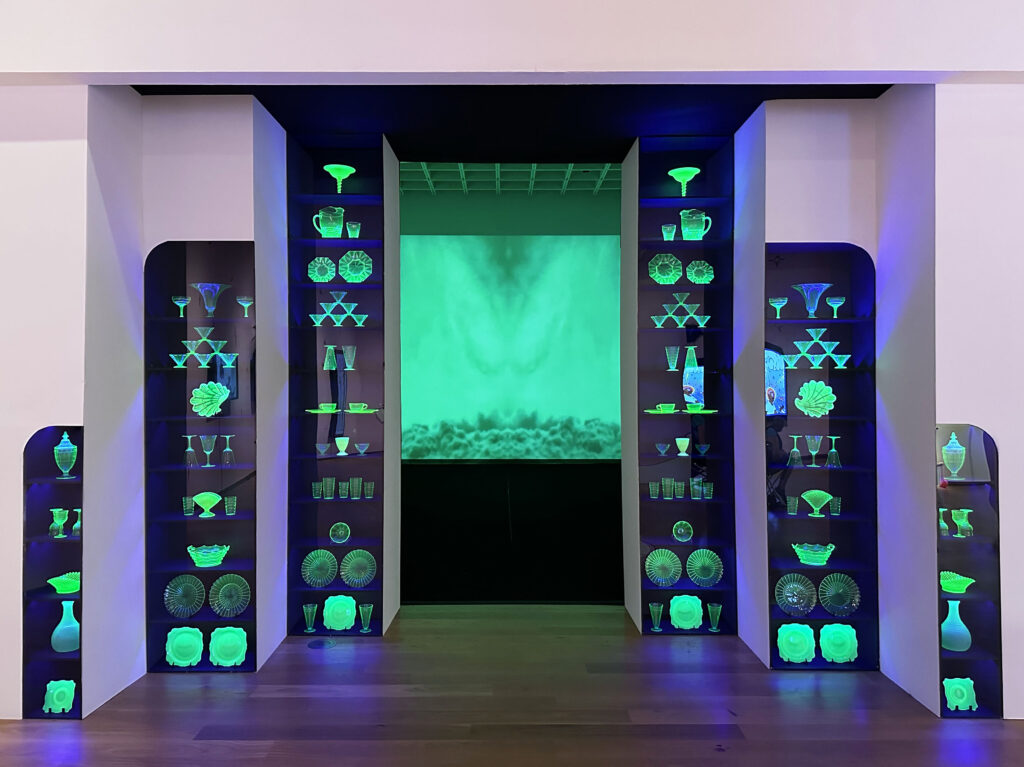


Cara Despain’s work feels especially timely with the recent release of Oppenheimer, a film about the scientist who led the effort to create the first atomic bomb. Her installation for this show is captivating- eerie glowing green glassware surrounds the entrance to a mesmerizing video installation, Test of Faith, where atomic explosions fill three walls as a Mormon hymn plays.
The museum’s information on the artist and her work-
Miami-based artist Cara Despain was born and raised in Salt Lake City, and the experience of growing up in the West informs much of her work. Through video, sculpture, photography, and installation she critiques a range of issues pertinent to the region that are also internationally relevant. These issues stem in part from the nineteenth-century concept of Manifest Destiny, the belief that Providence intended for American civilization to extend across the continent and benefit from all its yet untapped resources. That philosophy gave rise to such virtues associated with the character of the American West as optimism, independence, and self-reliance. It also engendered an unchecked hubris which has sometimes had tragic consequences. Among these unintended consequences are the human and environmental costs of atmospheric nuclear weapons testing from 1945-1962 which polluted vast areas of the West and inflicted disease and death on many of the region’s residents. Being from this region and having family that lived there during those tests, Despain has long had a deep concern about lingering effects of this exposure for the people downwind.
Despain’s two-part installation begins with six cabinets of glowing green glassware. This inexpensive Depression-era glass was popular for its vibrant green color. As a bonus, the glass is fluorescent and glows hauntingly in the dark under ultraviolet light. This seductive coloration is ominous, though, being produced by adding small amounts of uranium oxide to the glass mixture. While now we would not consider using radioactive dinnerware, Despain is demonstrating our once innocent relationship with this toxic element that made the atomic age possible.
The domestic, fragile uranium glass flanks the entrance to Test of Faith, an immersive video installation that is menacing and enthralling. The room is filled with a series of atomic explosions edited from vintage nuclear test footage from the Nevada Test Site, which was less than 150 miles from where her family in southern Utah originates. Projected simultaneously on three walls, billowing clouds in swirling tones of blue, green, and yellow build to a crescendo then fade before the next explosion. To heighten the darkly supernatural sensation, Despain shows each mushroom cloud divided in mirror form like Rorschach inkblots and we are left to see within these abstract patterns our own fears and trepidations. Accompanying this vision of cosmic destruction is the sound of the Mormon hymn “Love One Another” rising and falling in step with each detonation. The digitally altered synthetic timbre of the song completes the experience of facing the apocalypse and is reference to the insidious appeal to the assumed patriotism and obedient nature of the largely Mormon and ranching populations in the fallout region to support the testing.
Today, nuclear weapons testing may seem like a remote episode in American history associated with the Cold War and the once alarming spread of global Communism. Despain’s work is intended to remind us that the nuclear threat is still present, with more nations than ever expanding their arsenals or developing and testing new weapons.
